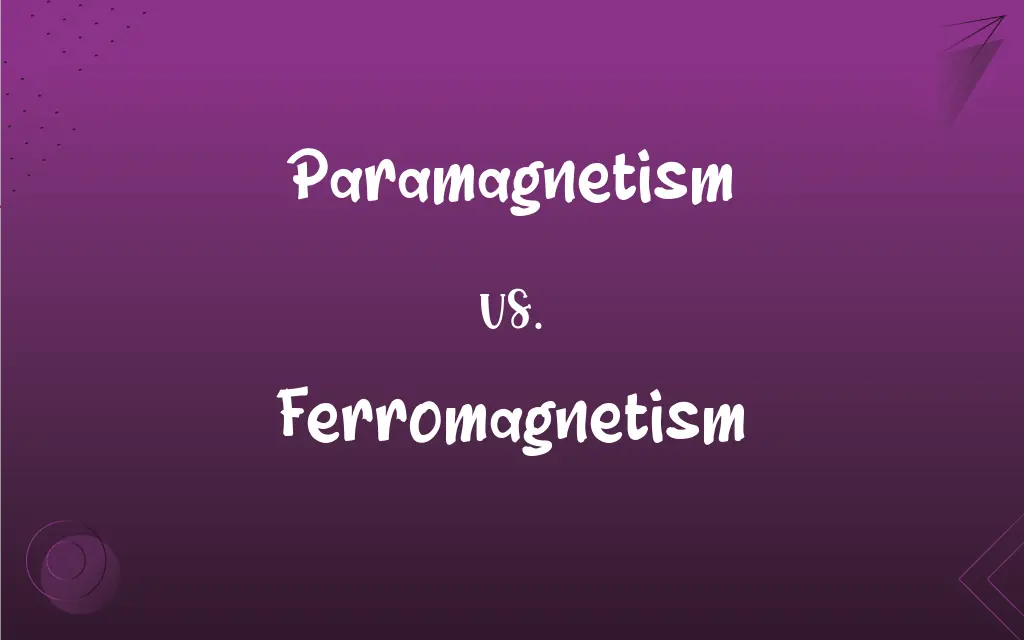Paramagnetism vs. Ferromagnetism: What's the Difference?
Edited by Janet White || By Harlon Moss || Updated on October 26, 2023
Paramagnetism is attraction to magnetic fields, weak and temporary.Ferromagnetism refers to strong, permanent magnetism.

Key Differences
Paramagnetism and ferromagnetism are distinct magnetic properties. Paramagnetism is a weak form of magnetism observed in materials with unpaired electrons, where magnetic moments align only in the presence of an external magnetic field and dissipate once the field is removed. Ferromagnetism, on the other hand, is a stronger form of magnetism found in materials like iron. Here, magnetic moments can align spontaneously, creating a permanent magnet even without an external magnetic field.
Materials exhibit paramagnetism due to the presence of some unpaired electrons that align with an external magnetic field, causing a slight attraction. Ferromagnetism occurs in materials with specific atomic structures where magnetic domains align to create strong, permanent magnets. Paramagnetism is a temporary phenomenon, disappearing when the external field is removed, whereas ferromagnetism leads to persistent magnetic properties.
Paramagnetism and ferromagnetism respond differently to temperature changes. In paramagnetic materials, magnetism decreases with increasing temperature as thermal agitation disrupts the alignment of magnetic moments. Conversely, ferromagnetic materials lose their permanent magnetism above a certain temperature, known as the Curie temperature, transitioning to a paramagnetic state.
While paramagnetic materials have a small, positive magnetic susceptibility and are weakly attracted to magnets, ferromagnetic materials exhibit a large, positive susceptibility and are strongly attracted. Paramagnetism is typically found in elements like aluminum and platinum, while ferromagnetism is characteristic of iron, cobalt, and nickel.
The effects of paramagnetism and ferromagnetism are crucial in various applications. Paramagnetic properties are utilized in MRI machines, where the alignment of spins in a magnetic field is key. Ferromagnetism is fundamental in data storage devices, electric motors, and generators due to its ability to maintain a stable magnetic field.
ADVERTISEMENT
Comparison Chart
Magnetic Strength
Weak and temporary
Strong and permanent
Magnetic Alignment
Only in an external magnetic field
Spontaneous, without external field
Temperature Dependence
Decreases with increasing temp
Loses magnetism above Curie temp
Magnetic Susceptibility
Small, positive
Large, positive
Example Materials
Aluminum, Platinum
Iron, Cobalt, Nickel
ADVERTISEMENT
Paramagnetism and Ferromagnetism Definitions
Paramagnetism
Temporary magnetic property disappearing without a magnetic field.
The paramagnetism in sodium chloride vanishes once the magnet is removed.
Ferromagnetism
Alignment of magnetic moments even without an external field.
The ferromagnetism in nickel shows spontaneous magnetization.
Paramagnetism
Magnetism in materials with unpaired electrons.
The paramagnetism in certain metal ions is due to their unpaired electrons.
Ferromagnetism
Persistent magnetic behavior above a certain temperature.
The ferromagnetism of cobalt persists until it reaches its Curie temperature.
Paramagnetism
Weak magnetic behavior in certain materials.
Liquid oxygen shows paramagnetism when exposed to a magnetic field.
Ferromagnetism
Large, positive magnetic susceptibility.
The strong ferromagnetism in steel is evident by its high susceptibility.
Paramagnetism
Alignment of magnetic moments in an external field.
The paramagnetism of aluminum is observable when it's near a strong magnet.
Ferromagnetism
Strong, inherent magnetic property in materials.
The ferromagnetism of iron allows it to be permanently magnetized.
Paramagnetism
Magnetic susceptibility that is positive but small.
The paramagnetism of copper sulfate is indicated by its slight attraction to a magnet.
Ferromagnetism
Magnetism in materials with specific atomic structures.
The ferromagnetism in rare earth magnets is due to their unique atomic arrangement.
Paramagnetism
Relating to or being a substance in which an induced magnetic field is parallel and proportional to the intensity of the magnetizing field but is much weaker than in ferromagnetic materials.
Ferromagnetism
Of or characteristic of substances such as iron, nickel, or cobalt and various alloys that exhibit extremely high magnetic permeability, a characteristic saturation point, and magnetic hysteresis.
Paramagnetism
(physics) The tendency of magnetic dipoles to align with an external magnetic field; materials that exhibit this tendency become temporary magnets.
Ferromagnetism
(physics) The phenomenon whereby certain substances can become permanent magnets when subjected to a magnetic field.
Paramagnetism
A property of materials which are not magnetized in the absence of an external magnetic field, but in which the magnetic moments of their constituents align with and enhance an applied magnetic field; the induced magnetic field of the substance is in direct proportion to the strength of the applied magnetic field; - opposed to diamagnetic and contrasted with ferromagnetic.
Ferromagnetism
Phenomenon exhibited by materials like iron (nickel or cobalt) that become magnetized in a magnetic field and retain their magnetism when the field is removed
Paramagnetism
Materials like aluminum or platinum become magnetized in a magnetic field but it disappears when the field is removed
FAQs
Can paramagnetic materials become permanent magnets?
No, paramagnetic materials cannot become permanent magnets as their magnetism is temporary and weak.
Are all metals either paramagnetic or ferromagnetic?
No, not all metals are paramagnetic or ferromagnetic; some are diamagnetic, showing a weak repulsion to magnetic fields.
What is a common ferromagnetic material?
Iron is a common ferromagnetic material.
What causes ferromagnetism?
Ferromagnetism is caused by the alignment of magnetic moments in certain materials, resulting in strong, permanent magnetism.
What happens to ferromagnetism at high temperatures?
Ferromagnetism in materials disappears above a specific temperature known as the Curie temperature, transitioning to a paramagnetic state.
Is the Earth's core paramagnetic or ferromagnetic?
The Earth's core is believed to be ferromagnetic, contributing to the planet's magnetic field.
Can ferromagnetism be induced in non-magnetic materials?
Ferromagnetism cannot be induced in non-magnetic materials; it's a property of specific materials.
How is the magnetic susceptibility of ferromagnetic materials characterized?
Ferromagnetic materials have a large, positive magnetic susceptibility.
Are paramagnetic materials used in everyday electronics?
While less common than ferromagnetic materials, paramagnetic materials can be used in certain electronic applications.
What is the difference between paramagnetism and diamagnetism?
Paramagnetism is weak attraction to magnetic fields, while diamagnetism is a weak repulsion.
What is an example of a paramagnetic material?
Aluminum is an example of a paramagnetic material.
Is water paramagnetic or ferromagnetic?
Water is neither paramagnetic nor ferromagnetic; it is diamagnetic.
What is paramagnetism?
Paramagnetism is a form of magnetism where materials are weakly attracted to a magnetic field and this attraction is temporary.
What are some applications of ferromagnetism?
Ferromagnetism is used in electric motors, data storage, and magnetic resonance imaging (MRI).
Can ferromagnetism be permanently lost?
Yes, ferromagnetism can be lost if the material is heated above its Curie temperature or physically altered.
How does temperature affect paramagnetism?
In paramagnetic materials, magnetism typically decreases with increasing temperature.
Can paramagnetism be easily observed?
Paramagnetism is generally weak and may require sensitive equipment to be observed.
What role do unpaired electrons play in paramagnetism?
Unpaired electrons are responsible for the weak magnetic properties seen in paramagnetic materials.
Do paramagnetic materials have a Curie temperature?
No, the concept of a Curie temperature is specific to ferromagnetic materials.
Can paramagnetic and ferromagnetic properties coexist in one material?
Some materials can exhibit both properties under different conditions, but typically one dominates.
About Author
Written by
Harlon MossHarlon is a seasoned quality moderator and accomplished content writer for Difference Wiki. An alumnus of the prestigious University of California, he earned his degree in Computer Science. Leveraging his academic background, Harlon brings a meticulous and informed perspective to his work, ensuring content accuracy and excellence.
Edited by
Janet WhiteJanet White has been an esteemed writer and blogger for Difference Wiki. Holding a Master's degree in Science and Medical Journalism from the prestigious Boston University, she has consistently demonstrated her expertise and passion for her field. When she's not immersed in her work, Janet relishes her time exercising, delving into a good book, and cherishing moments with friends and family.































































